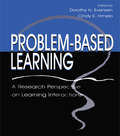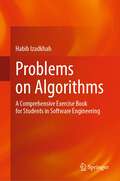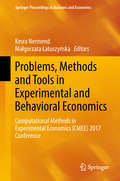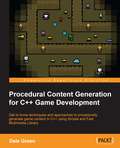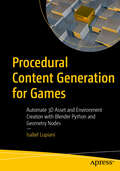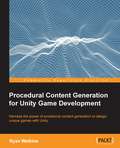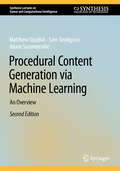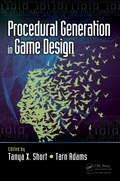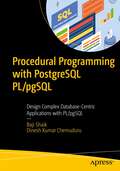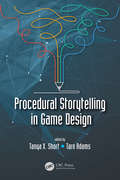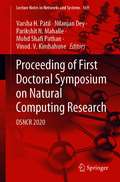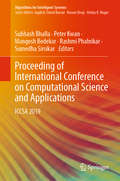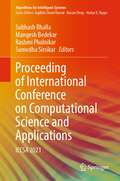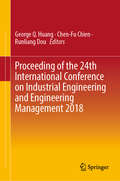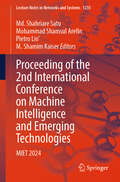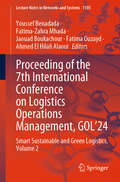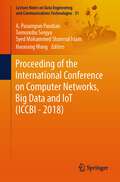- Table View
- List View
Problem-Based Learning: A Didactic Strategy in the Teaching of System Simulation (Studies in Computational Intelligence #824)
by Miguel Botto-Tobar Lorenzo Cevallos-TorresThis book describes and outlines the theoretical foundations of system simulation in teaching, and as a practical contribution to teaching-and-learning models. It presents various methodologies used in teaching, the goal being to solve real-life problems by creating simulation models and probability distributions that allow correlations to be drawn between a real model and a simulated model. Moreover, the book demonstrates the role of simulation in decision-making processes connected to teaching and learning.
Problem-based Learning: A Research Perspective on Learning Interactions
by Cindy E. Hmelo-Silver Dorothy H. Evensen Cindy E. HmeloThis volume collects recent studies conducted within the area of medical education that investigate two of the critical components of problem-based curricula--the group meeting and self-directed learning--and demonstrates that understanding these complex phenomena is critical to the operation of this innovative curriculum. It is the editors' contention that it is these components of problem-based learning that connect the initiating "problem" with the process of effective "learning." Revealing how this occurs is the task taken on by researchers contributing to this volume. The studies include use of self-reports, interviews, observations, verbal protocols, and micro-analysis to find ways into the psychological processes and sociological contexts that constitute the world of problem-based learning.
Problems on Algorithms: A Comprehensive Exercise Book for Students in Software Engineering
by Habib IzadkhahWith approximately 2500 problems, this book provides a collection of practical problems on the basic and advanced data structures, design, and analysis of algorithms. To make this book suitable for self-instruction, about one-third of the algorithms are supported by solutions, and some others are supported by hints and comments. This book is intended for students wishing to deepen their knowledge of algorithm design in an undergraduate or beginning graduate class on algorithms, for those teaching courses in this area, for use by practicing programmers who wish to hone and expand their skills, and as a self-study text for graduate students who are preparing for the qualifying examination on algorithms for a Ph.D. program in Computer Science or Computer Engineering. About all, it is a good source for exam problems for those who teach algorithms and data structure. The format of each chapter is just a little bit of instruction followed by lots of problems. This book is intended to augment the problem sets found in any standard algorithms textbook. This book • begins with four chapters on background material that most algorithms instructors would like their students to have mastered before setting foot in an algorithms class. The introductory chapters include mathematical induction, complexity notations, recurrence relations, and basic algorithm analysis methods. • provides many problems on basic and advanced data structures including basic data structures (arrays, stack, queue, and linked list), hash, tree, search, and sorting algorithms. • provides many problems on algorithm design techniques: divide and conquer, dynamic programming, greedy algorithms, graph algorithms, and backtracking algorithms. • is rounded out with a chapter on NP-completeness.
Problems, Methods and Tools in Experimental and Behavioral Economics: Computational Methods in Experimental Economics (CMEE) 2017 Conference (Springer Proceedings in Business and Economics)
by Kesra Nermend Małgorzata ŁatuszyńskaThese proceedings highlight research on the latest trends and methods in experimental and behavioral economics. Featuring contributions presented at the 2017 Computational Methods in Experimental Economics (CMEE) conference, which was held in Lublin, Poland, it merges findings from various domains to present deep insights into topics such as game theory, decision theory, cognitive neuroscience and artificial intelligence. The fields of experimental economics and behavioral economics are rapidly evolving. Modern applications of experimental economics require the integration of know-how from disciplines including economics, computer science, psychology and neuroscience. The use of computer technology enhances researchers’ ability to generate and analyze large amounts of data, allowing them to use non-standard methods of data logging for experiments such as cognitive neuronal methods. Experiments are currently being conducted with software that, on the one hand, provides interaction with the people involved in experiments, and on the other helps to accurately record their responses. The goal of the CMEE conference and the papers presented here is to provide the scientific community with essential research on and applications of computer methods in experimental economics. Combining theories, methods and regional case studies, the book offers a valuable resource for all researchers, scholars and policymakers in the areas of experimental and behavioral economics.
Procedural 3D Modeling Using Geometry Nodes in Blender: Discover the professional usage of geometry nodes and develop a creative approach to a node-based workflow
by Siemen Lens Wouter AdriaensenAn easy-to-follow, illustrated guide to learning the geometry nodes editor and various other facets of geometry nodes through simple exercises that progress to more challenging projectsPurchase of the print or Kindle book includes a free PDF eBookKey FeaturesDevelop a creative mathematical thinking of the modeling workflowUnderstand how Blender and geometry nodes store and manage the data that you are handlingLearn different scatter methods and how to use themBook DescriptionFor anyone working in the computer graphics industry, understanding how to use Blender's new geometry nodes tools to manipulate and generate 3D geometry in a node-based workflow is an essential skill. In this book, you'll learn how to use the basic and intermediate features of geometry nodes that are a crucial part of your Blender roadmap.You'll start by understanding the different node inputs and outputs followed by the basic nodes you'll need throughout your geometry nodes projects. The book will show you how the node system works and enable you to put your newfound knowledge to use through exercises that involve modifying curves, meshes, and more. You'll work on a range of interesting projects such as creating a procedural plant, where you'll use nodes to generate the intricate details and variations of a plant in a procedural manner, and a spiderweb generator to refine your skills of cleaning up a node tree. Finally, you'll build a procedural LED panel using geometry nodes to generate the look of an LED panel.By the end of this book, you'll be able to overcome any geometry node issue confidently and make complicated geometry node trees exactly how you need them.What you will learnDiscover the different node inputs and outputs that geometry nodes have to offerGet the hang of the flow of the geometry node systemUnderstand the common nodes you'll be using along with their functions in the geometry node editorModify basic mesh primitives using the node system inside BlenderScatter and modify objects aligned onto a curveBecome familiar with the more advanced nodes in the geometry nodes systemLink geometry and material nodes editors using named attributesImplement your new-found knowledge of nodes in real-world projectsWho this book is forIf you are a CG Artist or follow modeling careers like that of an environment artist or even a CG generalist in the cinematography industry and you are looking to get into learning a node-based modeling workflow using Geometry Nodes in Blender, this is the perfect book for you. You will need a basic knowledge of the fundamentals of Blender, for example, knowing the specific workflow of material nodes and being able to apply this knowledge to your projects. To get the most out of this book, you should have a basic understanding of Blender's shortcut system and some modeling experience.
Procedural Content Generation for C++ Game Development
by Dale GreenGet to know techniques and approaches to procedurally generate game content in C++ using Simple and Fast Multimedia Library About This Book * This book contains a bespoke Simple and Fast Multimedia Library (SFML) game engine with complete online documentation * Through this book, you'll create games that are non-predictable and dynamic and have a high replayability factor * Get a breakdown of the key techniques and approaches applied to a real game. Who This Book Is For If you are a game developer who is familiar with C++ and is looking to create bigger and more dynamic games, then this book is for you. The book assumes some prior experience with C++, but any intermediate concepts are clarified in detail. No prior experience with SFML is required. What You Will Learn * Discover the systems and ideology that lie at the heart of procedural systems * Use Random number generation (RNG) with C++ data types to create random but controlled results * Build levels procedurally with randomly located items and events * Create dynamic game objects at runtime * Construct games using a component-based approach * Assemble non-predictable game events and scenarios * Operate procedural generation to create dynamic content fast and easily * Generate game environments for endless replayability In Detail Procedural generation is a growing trend in game development. It allows developers to create games that are bigger and more dynamic, giving the games a higher level of replayability. Procedural generation isn't just one technique, it's a collection of techniques and approaches that are used together to create dynamic systems and objects. C++ is the industry-standard programming language to write computer games. It's at the heart of most engines, and is incredibly powerful. SFML is an easy-to-use, cross-platform, and open-source multimedia library. Access to computer hardware is broken into succinct modules, making it a great choice if you want to develop cross-platform games with ease. Using C++ and SFML technologies, this book will guide you through the techniques and approaches used to generate content procedurally within game development. Throughout the course of this book, we'll look at examples of these technologies, starting with setting up a roguelike project using the C++ template. We'll then move on to using RNG with C++ data types and randomly scattering objects within a game map. We will create simple console examples to implement in a real game by creating unique and randomised game items, dynamic sprites, and effects, and procedurally generating game events. Then we will walk you through generating random game maps. At the end, we will have a retrospective look at the project. By the end of the book, not only will you have a solid understanding of procedural generation, but you'll also have a working roguelike game that you will have extended using the examples provided. Style and approach This is an easy-to-follow guide where each topic is explained clearly and thoroughly through the use of a bespoke example, then implemented in a real game project.
Procedural Content Generation for Games: Automate 3D Asset and Environment Creation with Blender Python and Geometry Nodes
by Isabel LupianiLearn to procedurally generate 3D content for your next game or simulation using the Blender Python API and geometry nodes. Automate parts of your asset creation pipeline while producing a starter library of environments, weapons, and other objects ready to use in your next Unreal project. You will start by getting comfortable with generating geometry in Blender Python by automating hand modeling basics, like blocking out weapon meshes by combining primitives and manipulating them with your favorite operators and modifiers. After that you&’ll take a deep dive in geometry nodes and tackle projects such as adding Voronoi cracks and creating sliceform versions of any mesh. Building on your Blender Python skills, you&’ll progress to fractal methods for generating realistic terrain, followed by grammar-based approaches such as L-systems for producing lifelike plants. Prefer environments based on real-world locations? Find out how to generate 3D contents based on GIS data, such as city skylines from building footprints, and 3D terrain from Digital Elevation Models (DEM). Along the way, you will also learn techniques for incorporating parametric modeling into your procedural system to optionally control chosen aspects of the generation process, to ensure that only meaningful variations coherent with the overall design are produced. Whether you are looking to generate stylized content that aligns with your artistic vision, or realistic environments true to their real-world counterparts, this book will add a variety of practical (and fun) techniques to your procedural generation arsenal. What You Will Learn ● Automate 3D modeling steps traditionally done by hand with the Blender Python API and geometry nodes <p class="MsoNormal" style="text-indent: -18.0pt; line-height: normal; mso-pagination: widow-orphan; mso-list: l0 level1 l
Procedural Content Generation for Unity Game Development
by Ryan WatkinsHarness the power of procedural content generation to design unique games with Unity About This Book * Learn the basics of PCG development * Develop a 2D game from start to finish * Explore all the different ways PCG can be applied in games Who This Book Is For This book is for Unity game developers, especially those who work on indie games. You should be familiar with Unity and C# scripting but you'll be able to jump in and start learning PCG straightaway. What You Will Learn * Understand the theory of Procedural Content Generation * Learn the uses of Pseudo Random Numbers * Create reusable algorithm designs for PCG * Evaluate the data structures for PCG * Develop smaller games with larger amounts of content * Generate content instead of spending time designing every minute detail * Learn when and how to add PCG to your game * Learn the fundamental techniques of PCG In Detail Procedural Content Generation is a process by which game content is developed using computer algorithms, rather than through the manual efforts of game developers. This book teaches readers how to develop algorithms for procedural generation that they can use in their own games. These concepts are put into practice using C# and Unity is used as the game development engine. This book provides the fundamentals of learning and continued learning using PCG. You'll discover the theory of PCG and the mighty Pseudo Random Number Generator. Random numbers such as die rolls and card drafting provide the chance factor that makes games fun and supplies spontaneity. This book also takes you through the full development of a 2D game. Starting with level generation, you'll learn how PCG can make the game environment for you. You'll move into item generation and learn the different techniques to procedurally create game items. Thereafter, you'll be guided through the more abstract PCG areas such as scaling difficulty to the player and even generating music! The book helps you set up systems within your games where algorithms create computationally generated levels, art assets, quests, stories, characters, and weapons; these can substantially reduce the burden of manually creating every aspect of the game. Finally, you'll get to try out your new PCG skills on 3D terrain generation. Style and approach An easy-to-follow, project-based guide that will let you build a complete game by the end of the book using PCG.
Procedural Content Generation via Machine Learning: An Overview (Synthesis Lectures on Games and Computational Intelligence)
by Matthew Guzdial Sam Snodgrass Adam J. SummervilleThis book surveys current and future approaches to generating video game content with machine learning or Procedural Content Generation via Machine Learning (PCGML). Machine learning is having a major impact on many industries, including the video game industry. PCGML addresses the use of computers to generate new types of content for video games (game levels, quests, characters, etc.) by learning from existing content. The authors illustrate how PCGML is poised to transform the video games industry and provide the first ever beginner-focused guide to PCGML. This book features an accessible introduction to machine learning topics, and readers will gain a broad understanding of currently employed PCGML approaches in academia and industry. The authors provide guidance on how best to set up a PCGML project and identify open problems appropriate for a research project or thesis. This book is written with machine learning and games novices in mind and includes discussions of practical and ethical considerations along with resources and guidance for starting a new PCGML project.
Procedural Content Generation via Machine Learning: An Overview (Synthesis Lectures on Games and Computational Intelligence)
by Matthew Guzdial Sam Snodgrass Adam SummervilleThis second edition updates and expands upon the first beginner-focused guide to Procedural Content Generation via Machine Learning (PCGML), which is the use of computers to generate new types of content for video games (game levels, quests, characters, etc.) by learning from existing content. The authors survey current and future approaches to generating video game content and illustrate the major impact that PCGML has had on video games industry. In order to provide the most up-to-date information, this new edition incorporates the last two years of research and advancements in this rapidly developing area. The book guides readers on how best to set up a PCGML project and identify open problems appropriate for a research project or thesis. The authors discuss the practical and ethical considerations for PCGML projects and demonstrate how to avoid the common pitfalls. This second edition also introduces a new chapter on Generative AI, which covers the benefits, risks, and methods for applying pre-trained transformers to PCG problems.
Procedural Generation in Game Design
by Tarn Adams Tanya ShortMaking a game can be an intensive process, and if not planned accurately can easily run over budget. The use of procedural generation in game design can help with the intricate and multifarious aspects of game development; thus facilitating cost reduction. This form of development enables games to create their play areas, objects and stories based on a set of rules, rather than relying on the developer to handcraft each element individually. Readers will learn to create randomized maps, weave accidental plotlines, and manage complex systems that are prone to unpredictable behavior. Tanya Short’s and Tarn Adams’ Procedural Generation in Game Design offers a wide collection of chapters from various experts that cover the implementation and enactment of procedural generation in games. Designers from a variety of studios provide concrete examples from their games to illustrate the many facets of this emerging sub-discipline. <P><P>Key Features: <li>Introduces the differences between static/traditional game design and procedural game design <li>Demonstrates how to solve or avoid common problems with procedural game design in a variety of concrete ways <li>Includes industry leaders’ experiences and lessons from award-winning games <li>World’s finest guide for how to begin thinking about procedural design
Procedural Generation in Godot: Learn to Generate Enjoyable Content for Your Games
by Christopher PittLearn the tricks of simple procedural generation and how various genres, such as racing simulators, platformers, and roguelikes, can all benefit from these techniques. In this book, you'll learn how to combine hand-crafted content with algorithms to create immersive and beautiful environments. You'll learn how to create a seeding system, so that you can replay great levels with your friends. We'll cover how to create good tilesets, how to use the tilemap editor effectively, and how to inject just the right amount of logic into an otherwise automated machine that is your own personal procedural content generation engine. We will use 2D examples to demonstrate the concepts covered throughout the book. By the time you complete this book, you’ll have a good handle on how to add procedural generation to your games. What You Will LearnLearn to set up the perfect content generation system Master the tools for randomization and repeatabilityUnderstand how much content to craft versus how much to generateWho This Book Is ForBasic familiarity with the Godot engine and GDScript is essential. While all concepts are explained in the book, it can be overwhelming learning these techniques at the same time as learning the engine.
Procedural Programming with PostgreSQL PL/pgSQL: Design Complex Database-Centric Applications with PL/pgSQL
by Baji Shaik Dinesh Kumar ChemuduruLearn the fundamentals of PL/PGSQL, the programming language of PostgreSQL which is most robust Open Source Relational Database. This book provides practical insights into developing database code objects such as functions and procedures, with a focus on effectively handling strings, numbers, and arrays to achieve desired outcomes, and transaction management.The unique approach to handling Triggers in PostgreSQL ensures that both functionality and performance are maintained without compromise. You'll gain proficiency in writing inline/anonymous server-side code within the limitations, along with learning essential debugging and profiling techniques. Additionally, the book delves into statistical analysis of PL/PGSQL code and offers valuable knowledge on managing exceptions while writing code blocks. Finally, you'll explore the installation and configuration of extensions to enhance the performance of stored procedures and functions.What You'll LearnUnderstand the PL/PGSQL conceptsLearn to debug, profile, and optimize PL/PGSQL codeStudy linting PL/PGSQL codeReview transaction management within PL/PGSQL codeWork with developer friendly features like operators, casts, and aggregatorsWho Is This Book ForApp developers, database migration consultants, and database administrators.
Procedural Semantics for Hyperintensional Logic
by Marie Duží Bjorn Jespersen Pavel MaternaThe book is about logical analysis of natural language. Since we humans communicate by means of natural language, we need a tool that helps us to understand in a precise manner how the logical and formal mechanisms of natural language work. Moreover, in the age of computers, we need to communicate both with and through computers as well. Transparent Intensional Logic is a tool that is helpful in making our communication and reasoning smooth and precise. It deals with all kinds of linguistic context in a fully compositional and anti-contextual way.
Procedural Storytelling in Game Design
by Tanya X. Short Tarn AdamsThis edited collection of chapters concerns the evolving discipline of procedural storytelling in video games. Games are an interactive medium, and this interplay between author, player and machine provides new and exciting ways to create and tell stories. In each essay, practitioners of this artform demonstrate how traditional storytelling tools such as characterization, world-building, theme, momentum and atmosphere can be adapted to full effect, using specific examples from their games. The reader will learn to construct narrative systems, write procedural dialog, and generate compelling characters with unique personalities and backstories. Key Features Introduces the differences between static/traditional game design and procedural game design Demonstrates how to solve or avoid common problems with procedural game design in a variety of concrete ways World’s finest guide for how to begin thinking about procedural design
Proceeding of First Doctoral Symposium on Natural Computing Research: DSNCR 2020 (Lecture Notes in Networks and Systems #169)
by Nilanjan Dey Parikshit N. Mahalle Varsha H. Patil Mohd Shafi Pathan Vinod. V. KimbahuneThe book is a collection of papers presented at First Doctoral Symposium on Natural Computing Research (DSNCR 2020), held during 8 August 2020 in Pune, India. The book covers different topics of applied and natural computing methods having applications in physical sciences and engineering. The book focuses on computer vision and applications, soft computing, security for Internet of Things, security in heterogeneous networks, signal processing, intelligent transportation system, VLSI design and embedded systems, privacy and confidentiality, big data and cloud computing, bioinformatics and systems biology, remote healthcare, software security, mobile and pervasive computing, biometrics-based authentication, natural language processing, analysis and verification techniques, large scale networking, distributed systems, digital forensics, and human–computer interaction.
Proceeding of International Conference on Computational Science and Applications: ICCSA 2019 (Algorithms for Intelligent Systems)
by Subhash Bhalla Peter Kwan Mangesh Bedekar Rashmi Phalnikar Sumedha SirsikarThe book consists of high-quality papers presented at the International Conference on Computational Science and Applications (ICCSA 2019), held at Maharashtra Institute of Technology World Peace University, Pune, India, from 7 to 9 August 2019. It covers the latest innovations and developments in information and communication technology, discussing topics such as soft computing and intelligent systems, web of sensor networks, drone operating systems, web of sensor networks, wearable smart sensors, automated guided vehicles and many more.
Proceeding of International Conference on Computational Science and Applications: ICCSA 2021 (Algorithms for Intelligent Systems)
by Subhash Bhalla Mangesh Bedekar Rashmi Phalnikar Sumedha SirsikarThis book consists of high-quality papers presented at the International Conference on Computational Science and Applications (ICCSA 2021), held at Maharashtra Institute of Technology World Peace University, Pune, India, from 10 – 11 December 2021. It covers the latest innovations and developments in information and communication technology, discussing topics such as algorithms, data structures and applications; wireless and mobile networks; computer networks and communications; natural language processing and information theory; cryptography and information security.
Proceeding of the 24th International Conference on Industrial Engineering and Engineering Management 2018
by Chen-Fu Chien Runliang Dou George Q. HuangThis book records the new research findings and development in the field of industrial engineering, and it will serve as the guidebook for the potential development in industrial engineering and smart manufacturing. It gathers the accepted papers from the 24th International conference on Industrial Engineering and Engineering Management held at Central South University of Forestry and Technology in Changsha during May 19-20, 2018. The aim of this conference was to provide a high-level international forum for experts, scholars and entrepreneurs at home and abroad to present the recent advances, new techniques and application, to promote discussion and interaction among academics, researchers and professionals to promote the developments and applications of the related theories and technologies in universities and enterprises, and to establish business or research relations to find global partners for future collaboration in the field of Industrial Engineering. It addresses diverse themes in smart manufacturing, artificial intelligence, ergonomics, simulation and modeling, quality and reliability, logistics engineering, data mining and other related fields. This timely book summarizes and promotes the latest achievements in the field of industrial engineering and related fields over the past year, proposing prospects and vision for the further development.
Proceeding of the 2nd International Conference on Machine Intelligence and Emerging Technologies: MIET 2024 (Lecture Notes in Networks and Systems #1235)
by M. Shamim Kaiser Mohammad Shamsul Arefin Md. Shahriare Satu Pietro Lio'This book is a collection of high-quality research papers presented at the Second International Conference on Machine Intelligence and Emerging Technologies, MIET 2024, hosted by Noakhali Science and Technology University, Noakhali, Bangladesh, during 8-9 November 2024. This book focuses on theoretical, practical, state-of-art applications, and research challenges in the field of artificial intelligence and emerging technologies. It is helpful for active researchers and practitioners in this field.
Proceeding of the 7th International Conference on Logistics Operations Management, GOL'24: Smart Sustainable and Green Logistics, Volume 1 (Lecture Notes in Networks and Systems #1104)
by Youssef Benadada Fatima-Zahra Mhada Jaouad Boukachour Fatima Ouzayd Ahmed El Hilali AlaouiThis book presents the advances in the concept, model, method, and tools for the global supply chain management. The conference took place in Marrakesh from May 2 to May 4, 2024. The 7th edition of this conference focused on Smart Sustainable and Green Logistics. The papers included in the book's proceedings cover various themes, such as: . Metaheuristics for industry 4.0 . Multi-agent systems for solving combinatorial optimization problems . Sustainability in supply chain management: a paradigm for global transformation . Sustainable and agile supply chain management . Sustainable and smart management of water resources: innovative optimization . Artificial intelligence and emerging technologies: advancements and applications . Artificial intelligence techniques and statistical modeling for mobility and urban logistics planning . Smart and green process in transport and logistics . Viability of logistics networks, structural dynamics and recovery strategy—low certainty context . Modeling, simulation and optimization . Planning and scheduling . Decision support systems . Risk management . Project management . Information systems integration . Supply chain design and control . Models and algorithms for electric mobility
Proceeding of the 7th International Conference on Logistics Operations Management, GOL'24: Smart Sustainable and Green Logistics, Volume 2 (Lecture Notes in Networks and Systems #1105)
by Youssef Benadada Fatima-Zahra Mhada Jaouad Boukachour Fatima Ouzayd Ahmed El Hilali AlaouiThis book presents the advances in the concept, model, method, and tools for the global supply chain management. The conference took place in Marrakesh from May 2 to May 4, 2024. The 7th edition of this conference focused on Smart Sustainable and Green Logistics. The papers included in the book's proceedings cover various themes, such as: . Metaheuristics for industry 4.0 . Multi-agent systems for solving combinatorial optimization problems . Sustainability in supply chain management: a paradigm for global transformation . Sustainable and agile supply chain management . Sustainable and smart management of water resources: innovative optimization . Artificial intelligence and emerging technologies: advancements and applications . Artificial intelligence techniques and statistical modeling for mobility and urban logistics planning . Smart and green process in transport and logistics . Viability of logistics networks, structural dynamics and recovery strategy—low certainty context . Modeling, simulation and optimization . Planning and scheduling . Decision support systems . Risk management . Project management . Information systems integration . Supply chain design and control . Models and algorithms for electric mobility
Proceeding of the International Conference on Computer Networks, Big Data and IoT (Lecture Notes on Data Engineering and Communications Technologies #31)
by A. Pasumpon Pandian Tomonobu Senjyu Syed Mohammed Shamsul Islam Haoxiang WangThis book presents the proceedings of the International Conference on Computer Networks, Big Data and IoT (ICCBI-2018), held on December 19–20, 2018 in Madurai, India.In recent years, advances in information and communication technologies [ICT] have collectively aimed to streamline the evolution of internet applications. In this context, increasing the ubiquity of emerging internet applications with an enhanced capability to communicate in a distributed environment has become a major need for existing networking models and applications. To achieve this, Internet of Things [IoT] models have been developed to facilitate a smart interconnection and information exchange among modern objects – which plays an essential role in every aspect of our lives. Due to their pervasive nature, computer networks and IoT can easily connect and engage effectively with their network users. This vast network continuously generates data from heterogeneous devices, creating a need to utilize big data, which provides new and unprecedented opportunities to process these huge volumes of data. This International Conference on Computer Networks, Big Data, and Internet of Things [ICCBI] brings together state-of-the-art research work, which briefly describes advanced IoT applications in the era of big data. As such, it offers valuable insights for researchers and scientists involved in developing next-generation, big-data-driven IoT applications to address the real-world challenges in building a smartly connected environment.
Proceeding of the International Conference on Computer Networks, Big Data and IoT (Lecture Notes on Data Engineering and Communications Technologies #49)
by Klimis Ntalianis A. Pasumpon Pandian Ram PalanisamyThis book presents the proceedings of the International Conference on Computing Networks, Big Data and IoT [ICCBI 2019], held on December 19–20, 2019 at the Vaigai College of Engineering, Madurai, India. Recent years have witnessed the intertwining development of the Internet of Things and big data, which are increasingly deployed in computer network architecture. As society becomes smarter, it is critical to replace the traditional technologies with modern ICT architectures. In this context, the Internet of Things connects smart objects through the Internet and as a result generates big data. This has led to new computing facilities being developed to derive intelligent decisions in the big data environment. The book covers a variety of topics, including information management, mobile computing and applications, emerging IoT applications, distributed communication networks, cloud computing, and healthcare big data. It also discusses security and privacy issues, network intrusion detection, cryptography, 5G/6G networks, social network analysis, artificial intelligence, human–machine interaction, smart home and smart city applications.
Proceeding of the International Conference on Connected Objects and Artificial Intelligence: Connected Objects, Artificial Intelligence, Telecommunications and Electronics Engineering (Lecture Notes in Networks and Systems #1123)
by Youssef Mejdoub Abdelkebir Elamri’This book presents recent advances on Connected Objects, Systems, Telecommunications, Artificial Intelligence, and Electronic Engineering. On the connected objects side, the proceedings covered advancements in areas like sensor miniaturization, and networking to enable ever-more ubiquitous and autonomous IoT deployments. The AI-focused contributions explored novel machine learning architectures and training techniques tailored for resource-constrained edge devices. Key breakthroughs included federated learning models. In the telecommunications realm, the proceedings examined the critical role of 5G, 6G, and satellite communications in providing the high-bandwidth, low-latency connectivity required to unlock the full potential of AI-powered connected systems. This book is a collection of high-quality research papers presented at the 2nd International Conference on Connected Objects and Artificial Intelligence (COCIA'2024), held at High School of Technology, Hassan II University, Casablanca, Morocco, during 08–10 May 2024. This book features cutting-edge research and insights at the intersection of the important technology domains, Connected Objects, Systems, Telecommunications, Artificial Intelligence, and Electronic Engineering. It is designed for researchers, academicians, professionals, and graduates seeking to deepen their understanding and expertise at the intersection of IoT, AI, Telecommunications, and Electronic Engineering. This book includes: In-depth exploration of the latest advancements in connected objects and systems to enable autonomous IoT deployments. Detailed examinations of cutting-edge AI techniques optimized for edge computing environments, including federated learning and IA model compression. Insights into the critical role of 5G, 6G, and satellite communications in providing the high-performance connectivity required to unlock the full potential of intelligent, AI-powered IoT applications. With contributions from leading experts across academia and industry, this book equips readers with the knowledge and tools to drive innovation at the forefront of the connected intelligence revolution. It is an essential resource for anyone seeking to advance the state of the art in this rapidly evolving field.

